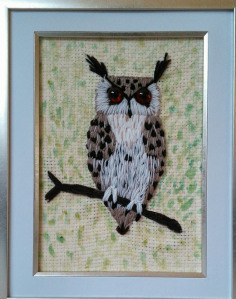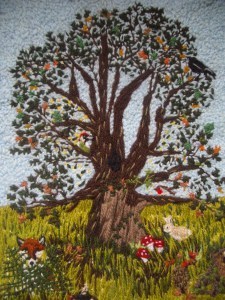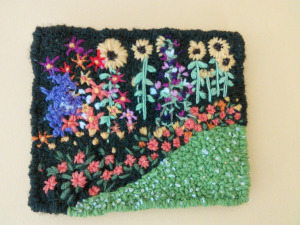So, what do I mean by free-hand tapestry…?
As a child did you have difficulty learning to tie up shoe laces? Was plaiting (or braiding) your hair a skill that took years and years to learn? Was colouring within the lines designed to flummox you and knowing your right from left was simply an abstract idea flouted by other people?
If any of these sound familiar it may be you have dyspraxia.
What does that have to do with tapestry?
In my case, quite a lot.
I was forty before I realised that my odd inability to master certain motor skills and patterns had a name. In fact it was only through teaching a severely dyspraxic student English that I became familiar with the term. Dyslexia I’d know about for years, and although I have a tendency to use malapropisms and spoonerisms in speech, I knew I wasn’t dyslexic – I teach English Literature and have worked a lot with dyslexic students. My student gave me a list of potential symptoms for dyspraxia – a wide and varied list – that I dutifully read to help me understand her needs.
Reading the list, my childhood struggles, and to a lesser extent adulthood ones, fell into place. I recognised myself.
Sooo… tapestry! More importantly free-hand tapestry. How does it fit in with my diagnosis? I’ll tell you how.
I remember doing tapestry and embroidery in primary school. I was terrible at it. I couldn’t pick up the neat little stitches. I couldn’t remember how to do them from one week to the next. The back of my canvas looked like knotty mess of vivid worms, the front little better. Other little girls were producing charming little samplers while I was producing misshapen monstrosities – at least according to the teacher’s reactions. I could see the difference between mine and my friends’ pieces but I couldn’t make the connection between my hands and my brain. I felt frustrated and stupid. And angry. It was a fairly familiar feeling; the same one I had when at three, another girl mocked me for colouring outside the lines. (Damn you, Audrey!) I could not, for the life of me, stick within the lines.
Then, about four years ago I decided to try to do a tapestry the way I paint with acrylics. Free, lots of building layers and colour, slapdash, bright, cheerful and joyful. I didn’t bother with the set types of stitches because I can’t retain them and I don’t understand why you have to keep to straight lines just because the canvas is a grid. I started small. A lot of things didn’t work but some did. And I got better – am still getting better, I hope. Most importantly, though, is the feeling that I’m creating something on my own terms, something that gives me pleasure, and something that feels organic, not prescribed.
Finally I realised it doesn’t matter about the lines. There are no lines if I don’t want there to be.
Tagged: colour, crafts, Developmental dyspraxia, do your own thing, tapestry, wool














